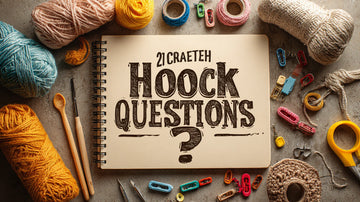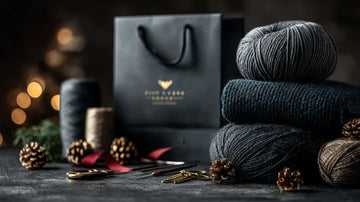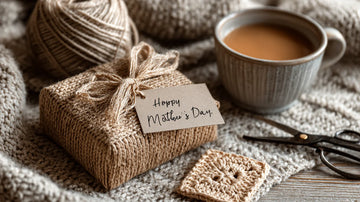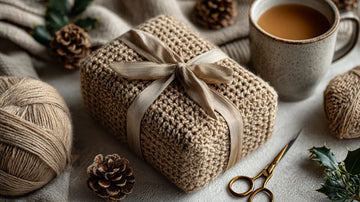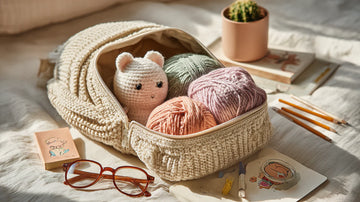Focus keyphrase: crochet hook FAQ
You’ve got a question about crochet hooks. In fact, you probably have a dozen. 🤔 From what size to use to which material is best, the world of crochet tools can be confusing for a beginner. The good news is, you're not alone! Many of the questions you have are common for every crafter. This definitive crochet hook FAQ guide will answer 21 of the most popular questions with clear, pro-level advice, giving you the confidence to pick up your hook and start creating. ❓💡
Your Top Crochet Hook Questions, Answered
1. What are the different parts of a crochet hook? A standard crochet hook has a handle for you to hold, a thumb rest for a stable grip, a shaft that determines the hook's size, a throat where the yarn rests as you pull through a stitch, and the head which grabs the yarn.
2. What’s the best hook for beginners? The best hook for a beginner is one that is comfortable and easy to hold. A hook with a soft, ergonomic handle in a common size (like a 5.0mm) is a great place to start. This reduces hand fatigue and helps you focus on mastering your stitches. Our Yarniss Large Ergonomic Crochet Hooks Set is a perfect example.
3. How do I know what size hook to use? The best way is to check the yarn label, which almost always provides a recommended hook size. However, this is just a starting point. To be sure, crochet a gauge swatch and see if your stitches match the pattern's recommendation. For more tips on this, explore our blog on Yarniss beginner crochet yarn.
4. What's the difference between US and Metric sizes? Metric sizes (in millimeters) are universal and precise (e.g., 5.0mm). US sizes are an older system that uses letters (B-Q) and numbers (0-19) that correspond to a range of millimeter sizes.
5. What is an ergonomic hook? An ergonomic hook is one designed to reduce hand and wrist strain. It typically has a wide, contoured handle that fits comfortably in your hand, eliminating the need for a tight pinch grip. This is a game-changer for long crafting sessions.
6. Do I need a whole set of hooks? While you only need one hook to start, a comprehensive set is a wise investment. It ensures you have the right hook for any project, yarn, or pattern. It also saves you from having to buy hooks one by one as your collection grows. Our Yarniss crochet kit is a fantastic starter set.
7. What's the best hook for tight tension? If you tend to crochet tightly, the best hook for you is one that has a very smooth surface (like aluminum) and a comfortable, ergonomic handle. This helps yarn glide more easily and encourages a relaxed grip. You can also go up a hook size to naturally create looser stitches.
8. What are inline vs. tapered hooks? An inline hook has a straight shaft and a head that is aligned with it, creating very uniform stitches. A tapered hook has a rounded head and a narrower throat, which allows for a faster, smoother glide. The best one for you is a matter of personal preference and project type.
9. What is a lighted crochet hook? A lighted hook has a small LED light built into the tip, illuminating your stitches. It's perfect for working with dark yarn or in low light, and it significantly reduces eye strain. Our Yarniss Counting Lighted Crochet Hooks Set combines this with a stitch counter.
10. How do I hold a hook correctly? There is no single "correct" way. The two most common grips are the Knife Grip (held like a dinner knife) and the Pencil Grip (held like a pen). The most important thing is to keep your hand and wrist relaxed, no matter which grip you use. For more tips, check out our Yarniss crochet for beginners blog.
11. Can I use a crochet hook for amigurumi? Yes! Amigurumi is the art of crocheting stuffed toys. It requires a specific hook size (usually a small one) to create a dense fabric that won't let the stuffing show through.
12. Why are some hooks made of plastic? Plastic hooks are a great, budget-friendly option. They are also incredibly lightweight, which makes them ideal for working with bulky yarn that can be heavy.
13. How do I choose a hook for bulky yarn? For bulky yarn, you need a large, lightweight hook (8mm or larger). A lightweight hook, such as plastic or wood, helps reduce hand fatigue from the weight of the yarn itself.
14. What's the best hook for lace? Lace requires a very small, steel hook. These hooks are designed to work with thin thread and have a precise, sharp tip for fine details.
15. How do I clean my hooks? Simply wipe them down with a soft, damp cloth. For wood hooks, you can occasionally use a small amount of wood care oil to keep them in good condition.
16. What's a Tunisian crochet hook? A Tunisian crochet hook is a long hook with a stopper at the end. It is used to create a specific kind of woven-looking fabric that combines elements of both crochet and knitting.
17. Can I use a knitting needle instead of a crochet hook? No, knitting needles and crochet hooks are fundamentally different. A knitting needle has no hook, and the two crafts use entirely different techniques.
18. What is a hook gauge? A hook gauge is a small tool with holes of different sizes that you can use to accurately measure the size of an unmarked hook.
19. Is a wood or bamboo hook better? It's a matter of preference! Bamboo hooks are warm and have a natural grip that's great for beginners. Aluminum hooks are smooth and fast. The best hook is the one that feels right in your hand.
20. Where do I store all my hooks? A dedicated crochet hook case is the best solution. It keeps all your hooks organized by size, protects them from damage, and makes them easy to find.
21. Are expensive hooks worth it? For a serious crafter, yes. High-quality hooks are a long-term investment in your comfort and your craft. An ergonomic hook, for example, can save you from a lifetime of hand pain. A quality set ensures your tools last for years.

